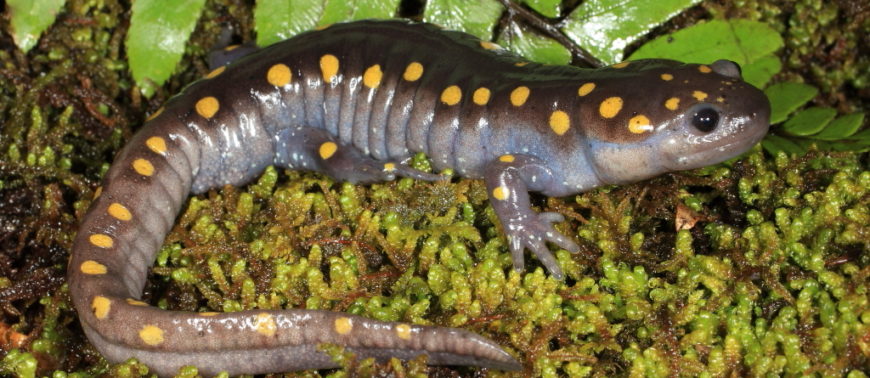Daylight is slowly fading, the temperature outside is around 60 degrees and a recent heavy rain has left the earth moist and wet. It is early March in Maryland and these conditions are just what is needed to jump-start an incredible salamander migration! I hurriedly head out the door towards the local bottomland woods, camera and flashlight in hand, to hopefully observe these wonderful amphibians.
Spotted salamanders are woodland creatures that live hidden under fallen logs, rocks or in abandoned tunnels under ground for most of the year. They are a fairly large salamander, reaching 7 to 9 inches in length. They are typically black with several yellow spots beginning at their head, and have double rows across their back and onto their tails. The amount of spotting varies greatly, and there are some individuals that are almost devoid of spots. They are found throughout most of Maryland with the exception of the lower Eastern Shore.
There is a small window of opportunity to see these incredible creatures in large numbers and above ground! In late winter or early spring, when the earth starts to thaw and the soaking rains begin, these salamanders emerge from their hiding places and begin to head toward the local vernal pool to breed and lay eggs. Vernal pools are temporary ponds which are created by melting snow and spring rains. They will eventually dry-up in the summer months. Fish cannot survive in this environment, but there are several wonderful and diverse aquatic insects, crustaceans and other amphibians that depend on this wetland for survival. Studies have shown that most of the salamanders live their entire lives within about 100 yards from their spring breeding areas, and return to the same vernal pool year after year to reproduce.
I am in luck this night! I can see several salamanders heading down the forest hill towards the pond. The calls of spring peeper frogs are deafening! There are wood frogs also calling in one section of the pond. There is a gravel road that parallels these woods and there are a few salamanders and frogs crossing this road as well. In the pool itself I can see several male spotted salamanders starting their nuptial dances! Just incredible amphibian activity!
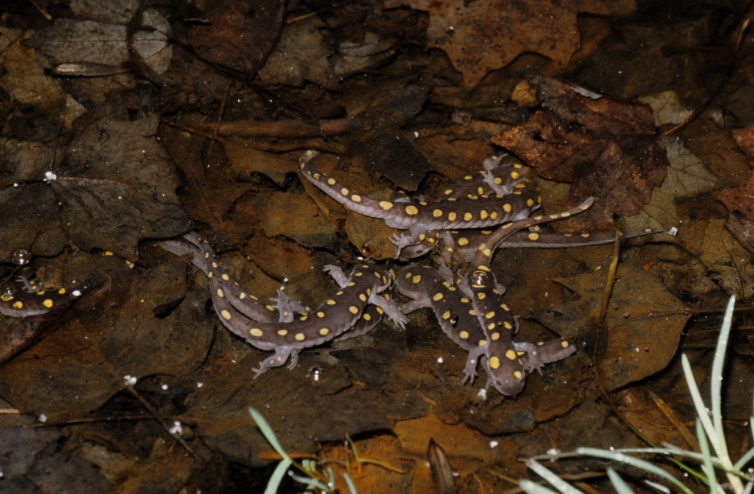
Typically, males arrive in the first waves of migration to the vernal pool and females soon follow. Males outnumber the females. Spotted salamanders utilize internal fertilization to fertilize their eggs. Males will deposit sperm capsules, called spermatophores, on the bottom of the pond or on submerged leaves, enticing females to “pick-up” their sperm. Competition soon starts and males will lay several sperm packets, sometimes on top of other male’s sperm capsules! When a female arrives, males will swim around her and nose bump and push other males out of the way all the while trying to entice the female to pick up their sperm packet. These actions are known as nuptial dances, and can involve many individuals. In the photo above, sperm capsules can be seen as the white objects attached to the leaves. It is difficult to observe this behavior for as soon as my flashlight shines on them, they disperse under the leaves. I turn off my flashlight and wait a few minutes. I point my camera in the direction of the activity, blindly, and take a flash photo and manage to capture the image above.
A few days after fertilization, females begin laying their eggs on submerged stems or sticks in the pond. Their egg masses are a compact milky white jelly, about the size of a tennis ball, and contain many individual eggs inside. Females may lay two to four different egg masses in the pond. Some females lay clear jelly masses, but in my experience the vast majority of egg masses are milky white in color. Scientists have shown that there is a symbiotic relationship between a type of algae, Oophila amblystomatis, and the developing embryo. The embryo provides a nitrogen rich environment for the algae from its waste, and in turn, the algae provides oxygen to the developing embryo. Egg masses are heavily preyed upon by tadpoles, newts, aquatic insects, and reptiles.
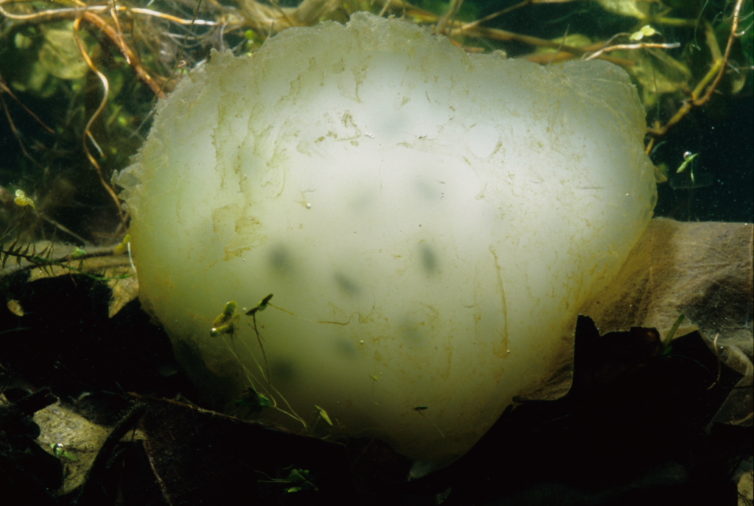
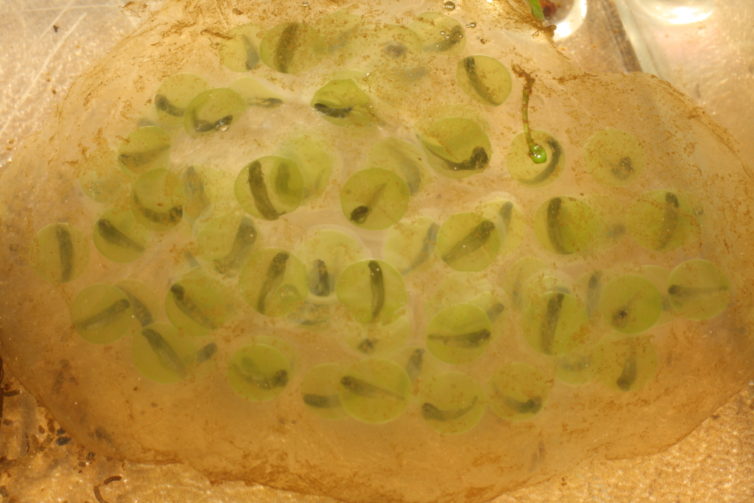
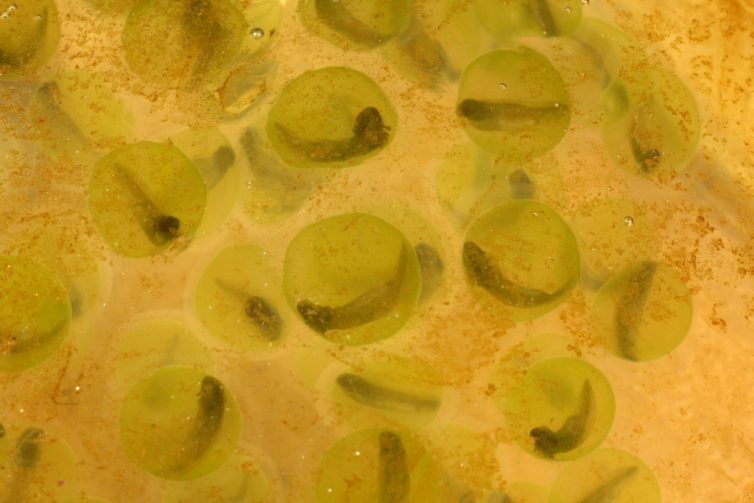
Once their eggs are laid, adults will slowly begin to leave the pond and return to their forest retreats. Now there is a race with time! The vernal pool will begin to shrink in size as the season progresses. Eggs that were laid in very shallow pools could literally dry-up after a few weeks with a lack of rainfall. If the water remains, spotted salamander egg masses will begin hatching after several weeks. Their fully aquatic larvae, equipped with feathery gills, begin to emerge from their eggs. Initially they do not possess limbs so nature has equipped them with balancer appendages growing from the sides of their heads! (You can see them clearly in the later stages of embryo development in the video clip). This allows them normal body positioning on the pond floor until their limbs develop. Larvae begin to disperse in the pond and become predators themselves. They will feed on small invertebrates, algae, worms, crustaceans, snails, and as they grow, tadpoles, and even each other! As the larvae develop, they begin to slowly absorb their gills, and in a few months, will leave the pool as young, air breathing adults. By the later part of June, the vernal pool is mostly gone, vegetation is taking over, and the area begins to blend into the rest of the woods.
I feel fortunate to have observed this activity tonight! I will return next year to see this wonderful event again, and hope I pick the right time to enjoy this small window of amphibian breeding explosion! I can’t help but ponder what would happen to this population if this area was developed. As a teenager, I used to visit a wonderful vernal pool near my home that supported so many amphibian species. Development destroyed the area and along with it, all the wonderful creatures that depended on the temporary woodland pools for survival. Fortunately, this current area I am visiting tonight is protected park land. In addition, vernal pool wetlands are becoming more and more recognized for their importance to our natural ecosystem. I am guardedly optimistic about the future of our spotted salamanders in Maryland.

